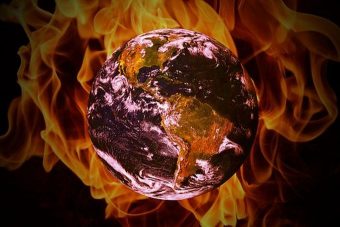
2 degrees Celsius has become the catchphrase that people around the world use when talking about climate change and how much average global temperatures will rise by the end of this century. It was the talisman that empowered the Paris climate accords in December 2015. It’s the amount of heating that many climate scientists say the earth can tolerate without global warming going completely off the rails and over a cliff.
But a new study by researchers at the University of Washington and funded by the National Institute of Health finds that average temperature rise will most likely be 3.2 degrees Celsius by 2100. They say 2°C is the “best case scenario.” In fact, they say there is a 90% chance that global temperatures will increase between 2° and 4.9° Celsius. That upper number is equivalent to just under 9° Fahrenheit.
“Our analysis shows that the goal of 2 degrees is very much a best-case scenario,” says lead author Adrian Raftery, a UW professor of statistics and sociology. “It is achievable, but only with major, sustained effort on all fronts over the next 80 years. Our analysis is compatible with previous estimates, but it finds that the most optimistic projections are unlikely to happen,” Raftery says. “We’re closer to the margin than we think.”
Statistically, the researchers found there is only a 5% chance that Earth will warm 2 degrees or less by the end of this century. The chance that warming will be at or below 1.5 degrees is less than 1%.
The most recent report from the Intergovernmental Panel on Climate Change (IPCC) included future warming rates based on four scenarios for future carbon emissions. The scenarios ranged from “business-as-usual” emissions from growing economies to serious worldwide efforts to transition away from fossil fuels.
“The IPCC was clear that these scenarios were not forecasts,” Raftery said. “The big problem with scenarios is that you don’t know how likely they are, and whether they span the full range of possibilities or are just a few examples. Scientifically, this type of storytelling approach was not fully satisfying.”
Rather than use the IPCC approach, the researchers focused on three factors they believe are more relevant to predicting climate change — total world population, gross domestic product per person, and the amount of carbon emitted for each dollar of economic activity, a factor known as carbon intensity.
Raftery says he and his colleagues expected total global population to correlate strongly with increasing world temperatures but their analysis did not support that theory. That is because most of the population increase will be in Africa, which uses few fossil fuels.
Carbon intensity — the amount of carbon emissions produced for each dollar of economic activity — did correlate strongly with rising temperatures, however. That value has been declining recently due to more efficient appliances and devices that use electricity. How quickly that value drops in future decades will be crucial for determining future warming.
The study finds a wide range of possible values of carbon intensity over future decades, depending on technological progress and countries’ commitments to implementing changes. “Overall, the goals expressed in the Paris Agreement are ambitious but realistic,” Raftery says. “The bad news is they are unlikely to be enough to achieve the target of keeping warming at or below 1.5 degrees.”
Source: cleantechnica.com

